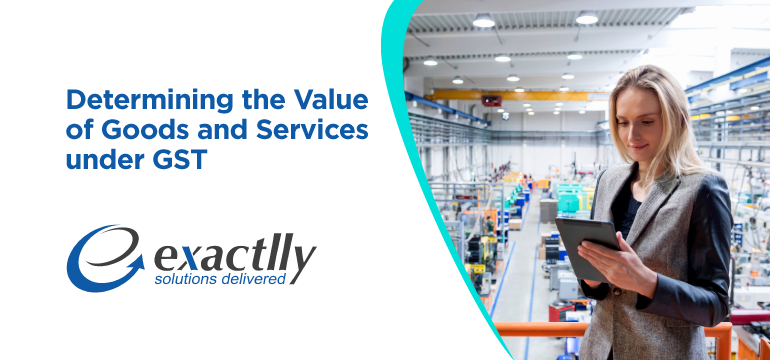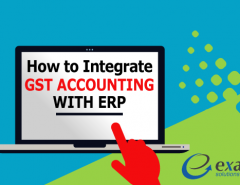Metrics are involved to determine the value of goods and services being sold in an economy – and these metrics differ from economy to economy depending on the financial and economical ecosystem. Under the current indirect tax regime in India, the value of a good or service in terms of its taxability is calculated taking various factors into account as follows –
- Excise Tax – based on quantity of goods, maximum retail price of the good or the transaction value
- VAT – based on the sale value of the good
- Service Tax – based on the taxable value of the service provided
Valuing a good or service under the current tax regime
Under the current regime, goods and services are valued as follows –
For example, F&M Clothing, a garment manufacturer sells garments to Lara Fashion for INR 5,000 and the maximum retail price of the garments are INR 8,000. The invoice issued contains the following details –
| Details | Rate |
| Garments | INR 5,000 |
| Less abatement at 31.5% on MRP | (INR 2,520) |
| Excise charged at 12.5% after abatement on MRP | INR 685 |
| VAT at 14.5% charged | INR 700 |
| Total | INR 6,385 |
Under the GST regime, goods and services are valued as follows –
For example, F&M Clothing, a garment manufacturer sells garments to Lara Fashion for INR 5,000 and the maximum retail price of the garments are INR 8,000. The invoice issued contains the following details –
| Details | Rate |
| Garments | INR 5,000 |
| GST at 18%* | INR 900 |
| INR 5,900 |
*Assuming GST of 18% on automobile spare parts
Therefore, as can be observed, under the GST regime, the transaction value of the goods and service is taken into account, or INR 5,000 as understood in the example.
Additional charges and expenses
In the GST regime, there are several questions to consider such as the treatment of additional expenses such as packing, discounts, dispatch etc. and whether they are included or excluded from the value of a transaction under the GST. For example, let us take F&M Clothing which sells garments worth INR 40,000 to Lara Fashion. INR 500 has been incurred as packing charges of the garments. Further, 1% discount has been put on accord of a promotion. F&M Clothing further provides a discount of 0.5% if Lara Fashion makes the payment before the 30th of the month using IMPS.
In that case, the invoice will contain the following details –
| Details | Rate |
| Garments | INR 40,000 |
| Packing charges | INR 500 |
| Discount at 1% | (-) INR 400 |
| GST at 18% | INR 7,218 |
| Total | INR 47,318 |
*Assuming GST of 18% on garments
Therefore, on this invoice –
- A packing charge has been included in the transaction value at INR 500 on account of the understanding that any packing expenses occurring at the time of supply of the goods or service may be included as part of the transaction value.
- Discount of 1% has been reduced from the value of the transaction on account of the discount being given at the time of making the supply of the good or service and thus can be deducted from the total transaction value in the invoice.
- A discount of 0.5% has not been shown as deduction as the same has not been given at the time of making the supply, instead the discount has been given after generating the supply and making the payment. Nonetheless, this discount may be linked to the invoice and claimed by way of producing a credit note to F&M Clothing for a value of 0.5% of INR 40,000 = INR 200 + GST at 18% on INR 200 = INR 36. This is require to be linked to the tax invoice relevant to the transaction and then deducted from the transaction value.
Exceptions to the Rule
When a discount is given after the supply has taken place and such discount is not known at the time of making the supply, then this falls as an exception to the above rule. For example, if F&M Clothing sells garments to Lara Fashion amounting to INR 40,000 and there is an agreement between the two parties stating that a credit period of 30 days is permitted for the purpose of making the payment. Despite this, F&M Clothing requests Lara Fashion to make the payment within 7 days due to it undergoing financial strain and states that if Lara Fashion complies, it shall be eligible for a further discount of 2%. Owing to this, Lara Fashion makes the payment within 7 days.
In this event, the further discount of 2% was not known to Lara Fashion when the supply of the garments was made and thus cannot be claimed as a deduction from the total value of the transaction for the purpose of determining the GST calculation.
We have provided a short brief of the effect that discounts have on transaction values as follows –
| Discount | Effect on the Value of the Transaction |
| Discount given before the supply or at the time of the supply and the same has been recorded in the invoice so generated | The discount may be claimed as a deduction from the total value of the transaction |
| Discount has been given after the supply of the good or service however the same was agreed to before or upon making the supply and the discount may be linked to a particular invoice | The discount may be claimed as a deduction from the total value of the transaction |
| When the discount has been given after the supply of the good or service and was not known at the time of making the supply | The discount cannot be claimed as a deduction from the total value of the transaction |
We have provided a brief overview of the effect that charges and expenses have on the total value of the transaction as follows –
| Expense | Example | Effect on the Value of the Transaction |
| Incidental expenses | Packing, commission | Is included in the value of the transaction |
| Delayed payment by the supplier | Interest, late fee, penalty | Is included in the value of the transaction |
| Any subsidies provided except those provided by the central or the state governments | – | Is included in the value of the transaction |
| Any other tax apart from the GST | – | Is included in the value of the transaction |
| An amount payable by the supplier but incurred by the receiver | – | Is included in the value of the transaction |
Therefore, it is expected that the GST regime is going to bring about several changes to the entire tax structure in India and is going to make businessmen and dealers alike, reassess pricing of goods and services, determining their value, pricing products etc. The GST is therefore going to bring about a significant transformation and simplification of the overall process of tax calculation.







Leave a Reply